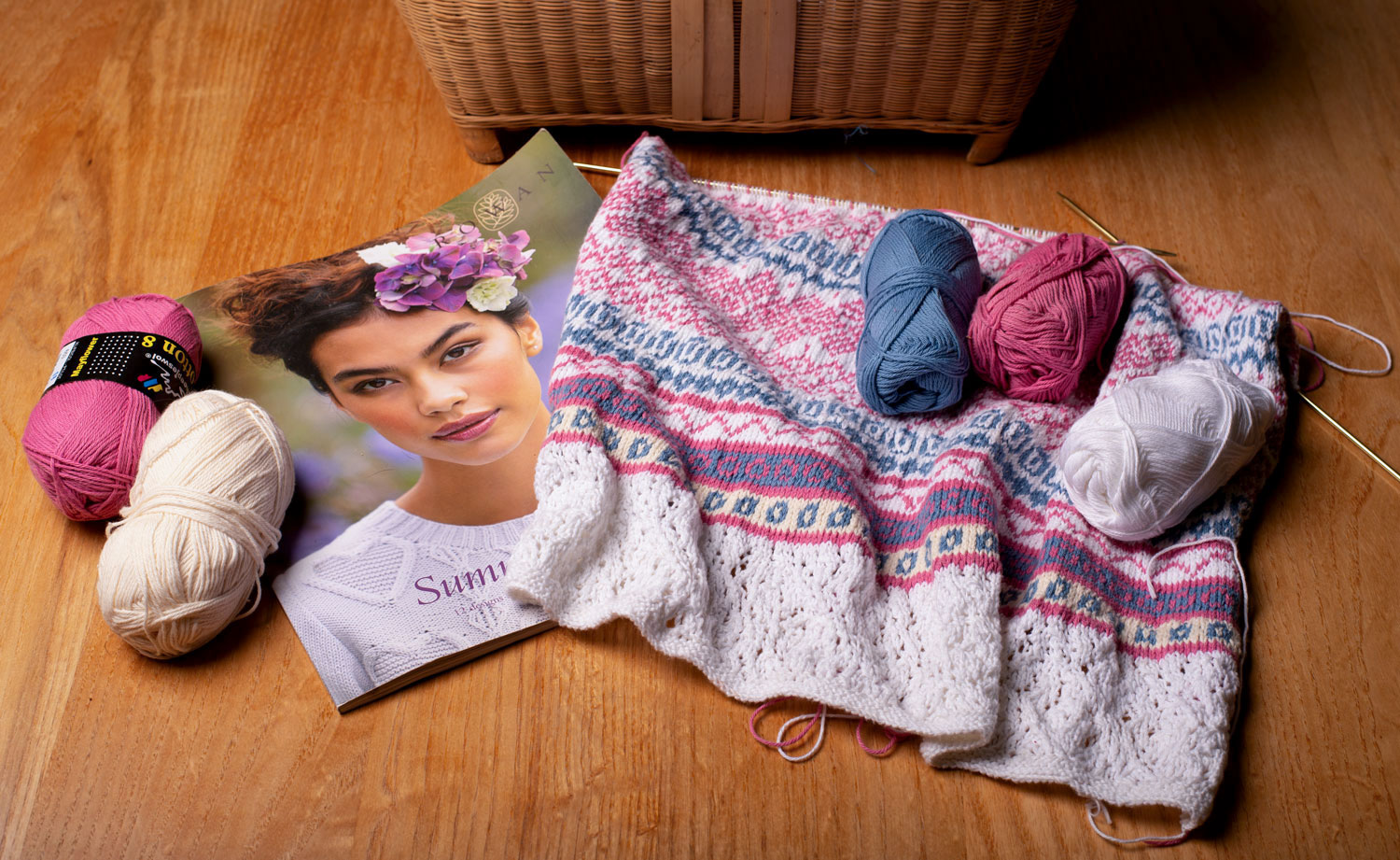How Crafts Help Us Cope
Photos by Forrest Anderson and Tai Anderson
The world has experienced a craft renaissance as we have all sheltered at home over the past few months. It’s far from the first time people have turned to crafts to cope with a global crisis. Crafts, including the knitting of army socks and other items for troops at the front and injured soldiers, have long been a staple of wars. They also tend to boom in recessions when people turn to DIY projects to save money.
As we have hunkered down waiting for the coronavirus to pass, crafts have risen to the fore as a strategy to help tamp down anxiety, assist children in coping with being at home from school and help vulnerable populations who must stay home to avoid getting the coronavirus. It has long been known that crafts help people heal, cope with stress and develop stronger life skills. Why? Crafting has these effects:
- Helping us cope as we wait for the crisis to be over - Mental health experts have encouraged people to pick up old crafts or get into new ones partly because there is little many of us can do about the pandemic except wait it out. This is akin to the famous knitting that women did in London bomb shelters during World War II to help them keep calm. Many people feel helpless because the pandemic requires not going out and doing something to solve the problem, but staying home and waiting for it to subside. Crafts can help us get through this time because they also require patience, focus and persistence. Studies indicate that crafts have the ability to help with both emotional and physical coping. They shift our attention away from threats such as negative news and enable us to be productive in troubled times.
- Reducing stress and anxiety, which in turn reduces disease - Knitting and crocheting have been called the 21st century yoga because of their ability to help alleviate stress. Around 45 million Americans know how to knit or crochet and a third buy knitting or crocheting supplies at least once a month. They mostly are women aged 25-40. Many people find that repetitive crafts such as knitting and crocheting are a form of meditation that minimizes the effects of stress. Crafting allows us to enter a state of relaxation and well-being, to become absorbed in what we are creating with our hands.This state is similar to the calming effect achieved through meditation. Repetitive motions of crafting such as knitting or sewing quiet the fight or flight response that contributes to keeping our bodies in a constant state of unhealthy stress. I once had a friend who was a professional violinist. Like many violinists, she knitted to keep her fingers strong and flexible. While undergoing cancer chemo treatments, she knitted baby caps to donate to NICU units. When I told her how impressed I was that she was thinking about others while getting the treatments, she replied that she was able to get through them without having panic attacks because she knitted during them. It’s always been interesting to me to see a professional woman waiting for a flight in an airport snap her laptops shut at 5 p.m. and pull out a knitting or crocheting project. Many people like to unwind after work by doing crafts.
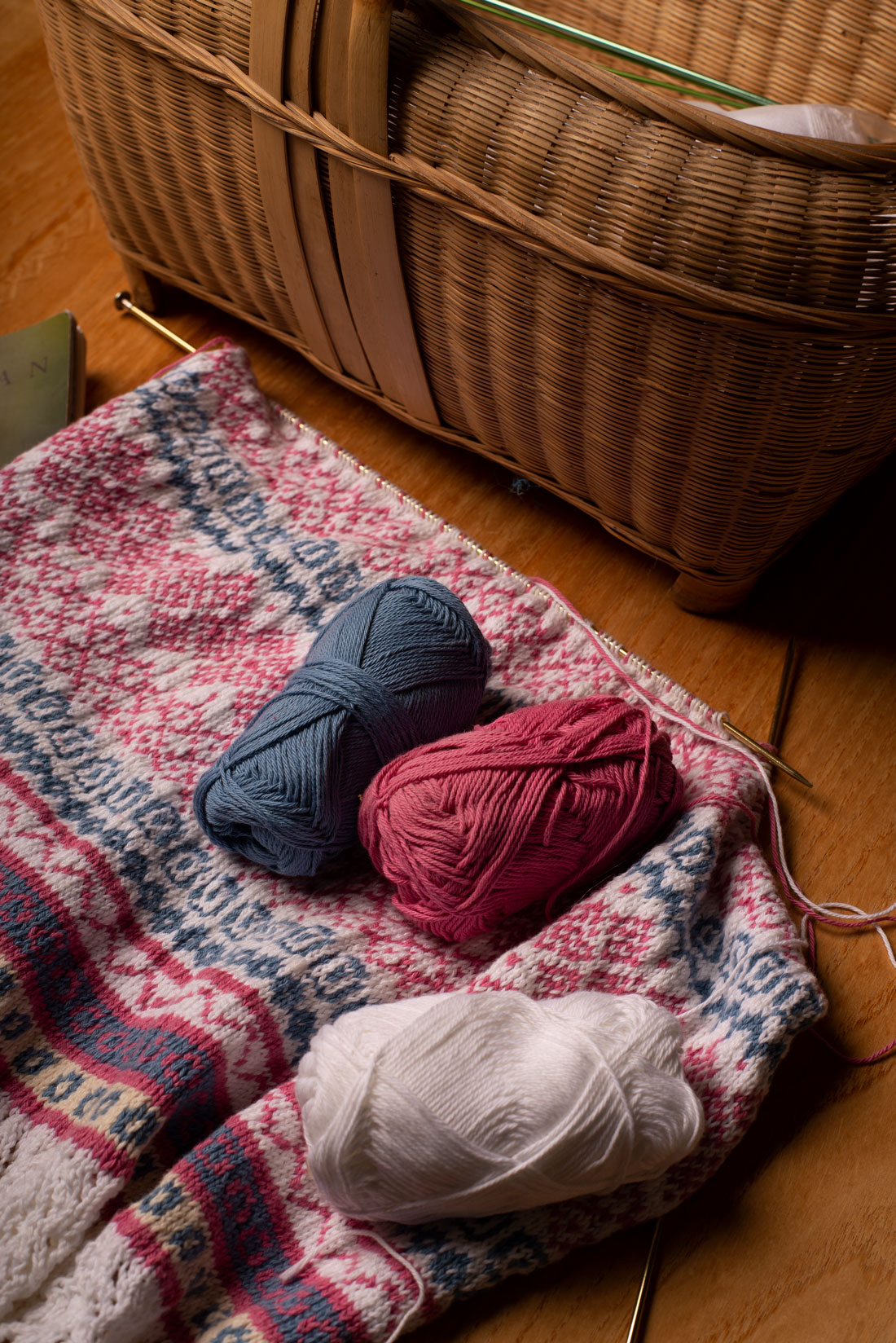
- Giving us joy and relieving depression - This is the most well-known benefit of crafts. Manual activities such as crafts have been shown to release serotonin, a natural anti-depressant that makes us feel happy. We feel joy from seeing our creativity evolving as we work on a project, and satisfaction and pride when we have created something in which we have invested our time and talents. A study of more than 3,500 knitters published in The British Journal of Occupational Therapy indicated that 81% of respondents with depression reported feeling happy after knitting and more than half felt very happy. Crafting also blends intellectually stimulating and relaxing, rewarding activities, two features that for many people are the essence of enjoyment.
- Building our self-esteem - The process of visualizing, working on and then creating a project helps people feel better about themselves. Studies indicate that crafts help people reach a state of mind in which they forget their worries and gain a sense of mastery. This in turn gives them a sense of self-esteem and achievement that enables them to deal better with less controllable situations such as demanding jobs, fear of unemployment and difficult relationships.
- Improving mental agility and an ability to handle unfamiliar situations - This skill is developed when we take on a new craft that we have to research and follow directions to master. Crafting involves many parts of the brain – planning, memory, attention span, creativity and problem solving. Crafting promotes creative thinking and decision making, and can help us make better decisions in all areas of our lives. It stimulates new brain connections. People who do crafts have been shown in studies to make better, fast decisions than people who don’t. Crafts require focused concentration on a very small part of our world. Most craft projects don’t have huge consequences if our efforts go awry. Crafts provide an ideal environment to experiment, improve our problem solving skills and learn a creative workflow. This is not the case with most jobs, which occur in a stressful and constantly changing environment with many moving parts and people. Doing a craft project can make us feel like we can control a small piece of our world and enjoy measurable success. It also occupies a slice of time during which we can live in the present without worrying about the past or the future. This helps us focus on what is real in our life now, not what was or could be.
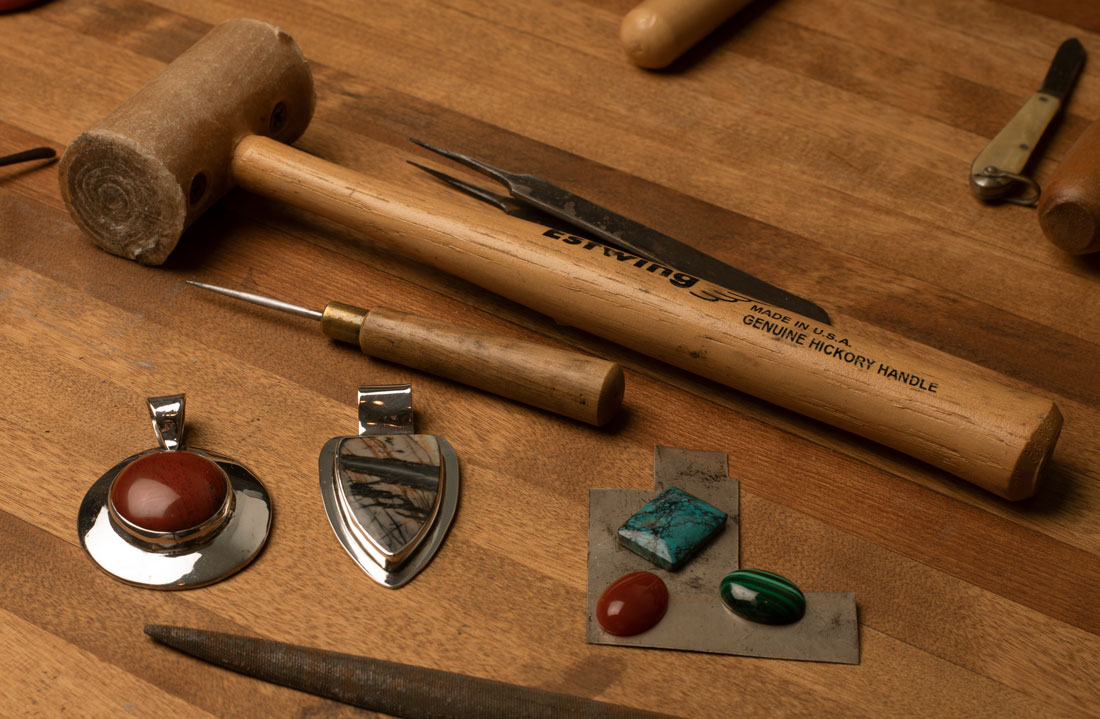
The process of making jewelry requires going through a creative workflow of researching and designing a project, gathering materials, creating it and refining and polishing it. Each stage requires planning, patience, creativity and persistance. All of these skills are transferable to many other areas of life.
- Crossword puzzles have long been known to help people maintain and enhance their cognitive abilities, but the same is believed to be true of quilting that uses complex patterns. Quilting requires visual and spatial planning and analysis, whereas knitting and other similar crafts use memory and math.
- Postponing age-related memory loss - A number of studies indicate that knitting and crocheting in particular can postpone age-related memory loss and help calm people who are experiencing signs of dementia. Knitting in particular was found to reduce dementia by as much as 50 percent in a Mayo Clinic study. A study published in the Journal of Neuropsychiatry & Clinical Neuroscience indicated that people between the ages of 70 and 89 who participated in crafts such as knitting and quilting had a lower risk of mild cognitive impairment similar to that of people who read books, work on computers or play cognitive games. The conclusion was that crafting may be among mentally engaging activities that protect the brain from decline. One study indicated that memory performance was enhanced after people knitted for a short time.
- Helping people with eating disorders – A small Canadian study of women undergoing inpatient treatment for anorexia nervosa indicated that about a third said knitting lessons lowered the intensity of their fears and their focus on their eating disorder.
- Coping with chronic pain – Chronic pain can lead to depression, social isolation and a feeling of loss of control and identity. A small British study showed that 60 people who were knitters had an increased sense of purpose, meaning and control and felt that knitting distracted them from their pain.
- Mitigating insomnia - Focusing on a soft, easy, repetitive crocheting or knitting project just before bed can help the body and mind wind down enough so a person can go to sleep. A Mind/Body Medical Institute study of insomnia patients showed that 100 percent of them had improved sleep, and 90 percent were able to stop taking sleep medication when they became involved in knitting.
- Building friendships and a sense of community – Many people find purely social situations stressful and prefer to build a support community around positive activities that automatically give them safe topics to discuss with others. Some people relax when they do an activity with other people, as the craft helps conversation flow and avoids them feeling self conscious or nervous about what to do with their hands or where to start in striking up a conversation. They also are at ease if a conversation lapses because everyone is focusing on the craft. In the British study of knitters cited above, the participants reported that participating in a knitting group increased their happiness and self-esteem. It is positive to be a part of a group that is focused on creating. During the pandemic, meeting in person is impossible, but craft-related socializing online is helping many people combat loneliness and isolation. A number of craft suppliers have realized this and are meeting their customers where they are - at home - and providing on-line classes or other ways for people to share their hobbies on-line. A craft also is a happy, quiet activity to share with family members in the same household.
- Helping to process grief – Crafting has been found to help people overcome grief. Yarn in particular has comforting, mood-lifting textures and colors that help people knit their way to recovery. Spending a short time daily on a craft can give people who are grieving a few minutes of joy and respite, which can be a start in helping them regain a sense of well-being for longer periods of time.
- Improving our connections between our brain and fine motor skills – Crafts usually require repetitive motions.These help calm the body and brain, maintain and improve fine motor skills and keep fingers and hands toned and dexterous. Crafts and other manual work improve our ability to coordinate our thinking with our hands and to be more precise.

Doing woodworking helps us learn precision, geometry and how to turn raw materials into finished products.
- Expressing ourselves – Crafts help us to do this and to develop our aesthetic sense. They give many people who have difficulty expressing themselves verbally a way to express their emotions and thoughts. Even the simplest medium such as paper can provide a way to develop and express our talents, sometimes on a very high artistic level.
- Teaching children - Many people are using crafts to help occupy and teach their children while sheltering at home. Crafts provide a bridge to the missing hands-on part of school that children are not getting from on-line school. Crafts help children, like adults, to have a sense of control when their world seems out of control. Crafts also can help them express feelings they don’t know how to verbalize.
- Creating gifts – Many people get great satisfaction from creating handmade gifts for other people. This adds to the sense of happiness from crafting. Crafts are a way to replenish our soul, relieve stress and provide service for others.
- Helping the environment - Some crafts promote recycling, such as refurbishing furniture or creating objects from parts of old ones that would otherwise add to a landfill. Few things are more rewarding than giving an object new life that extends its usefulness and appeal.
- Providing a path for improvement - With each project, people learn new things that help them improve the next project and enjoy their hobbies more. In some cases, what began as a hobby can have a major impact on their lives. Woodworking, which began for my husband and me as a way to meet a need, eventually resulted in us building about 75 pieces of furniture plus doing some construction work on our house. An obsession with drawing and painting became a design career for me, and my husband’s hobbies of photography and then computers developed into his life’s work. Many people have turned a hobby into their livelihood. With crafts, we hone general skills such as research, decision making, planning projects, making them and adding final polish. These skills are transferable to larger, more complex settings.
- Escaping - Crafts can be restful when we are tired because many of them are repetitive. If we are following a pattern, we can relax without coming up with something new. Crafting can help provide the kind of benefits that walking, biking, or traveling do as far as enabling us to escape from our routine of commuting, work pressures, household chores or coping with larger life challenges. If we enjoy exploring other cultures through travel, crafting can enable us to incorporate new hobbies from these cultures into our lives at home. When I’m not sheltering at home, I travel a fair amount, and I always visit fabric and art stores in different cities and countries. I often bring home materials, books or ideas for new hobbies or projects. This habit has helped me during the pandemic, as I have about an hour and a half a week when I can escape to my basement and enjoy not just a hobby but a different culture. Many countries have rich craft traditions and large craft stores which sell craft materials on-line.
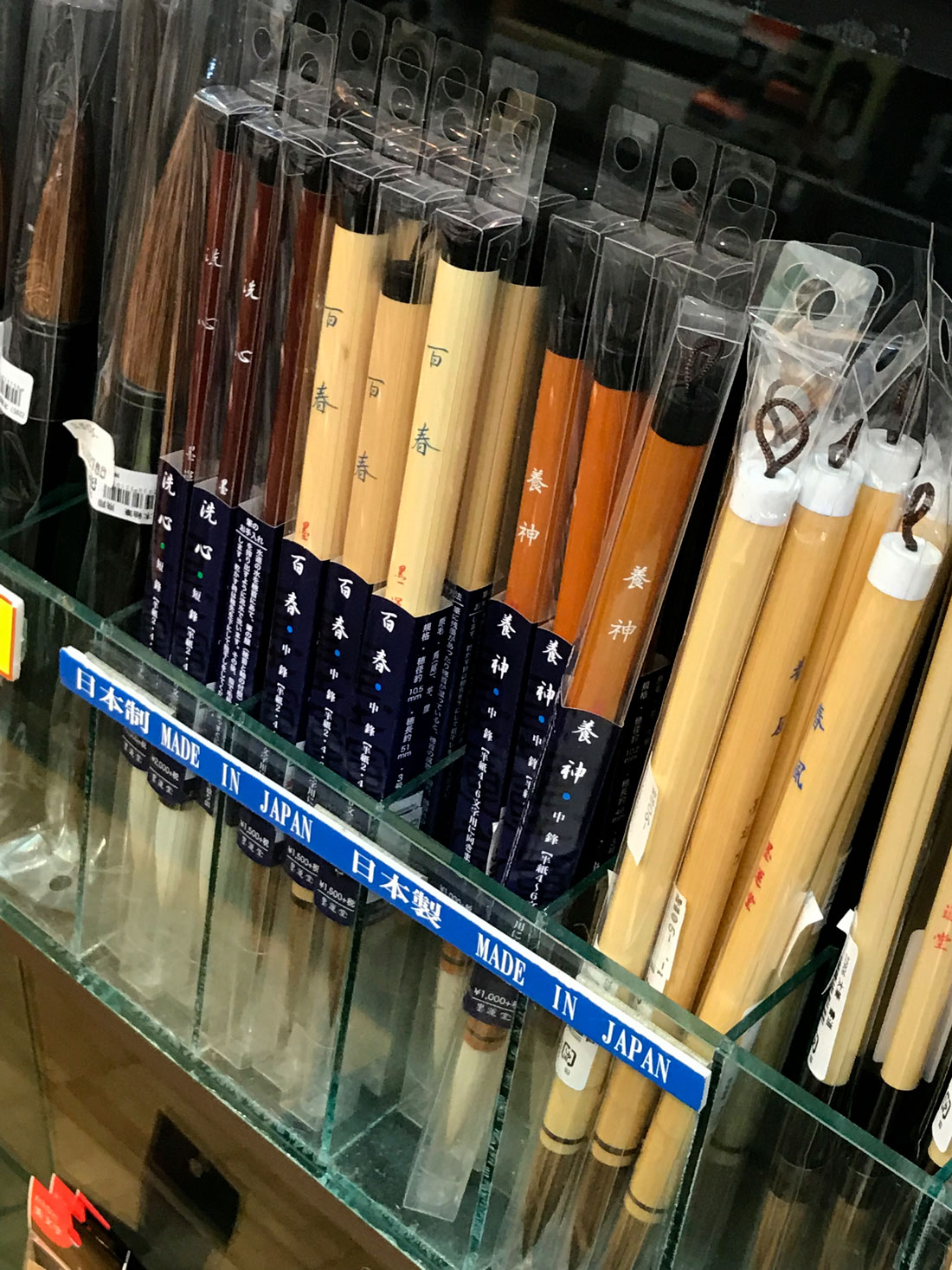
Japanese art brushes at a store in Tokyo and, below, the wonderful world of Japanese paper. These types of supplies can be purchased online to enable you to pursue crafts from different cultures at home.
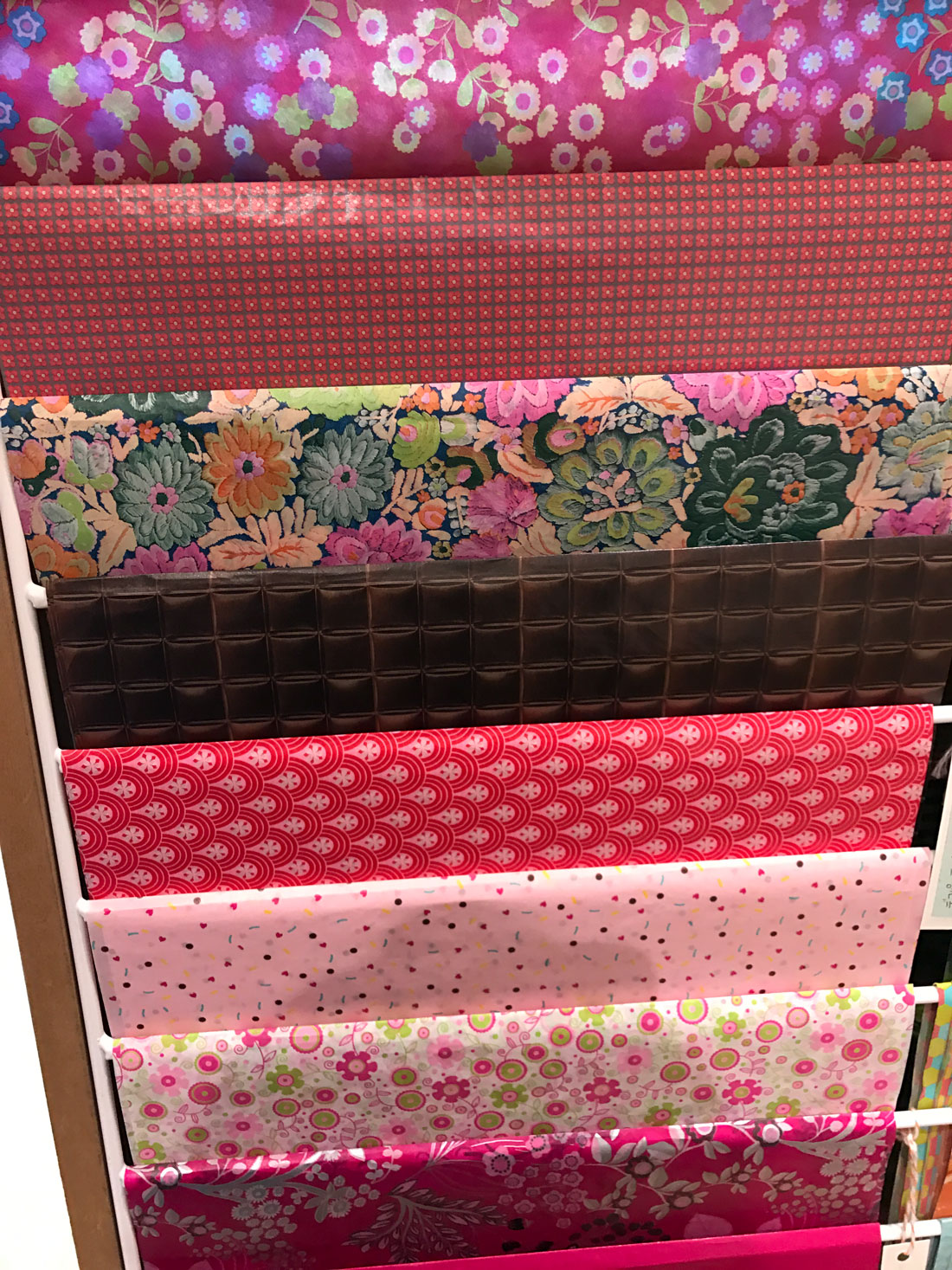
Some crafts can be done virtually anywhere, while others are more conveniently done at home because they require equipment such as machines or supplies.
Some people find crafts stressful, often because they underestimated the amount of work and skill a project requires, they are trying to do a project too quickly, or the materials were more expensive than they thought they would be or they purchased the wrong ones. For some, crafts seem like one more thing on top of an already swamped schedule. If you’re in that boat, this probably isn’t the time to start a new hobby. However, if you have the time and want to get involved in a craft, here’s how to have a positive experience :
- Start by buying a beginner’s kit and following the instructions. Make something small and then move up step by step to more ambitious projects. My husband and I started woodworking by creating six-foot bookcases out of very thick, rough ash boards. We survived and we still use the bookcases, but I certainly wouldn’t recommend that approach. We’re lucky we didn’t get hurt using power tools that we weren’t familiar with. Instead, make something small and simple so you get the feel of the medium and tools. Then move up to slightly more difficult or larger projects.
- Gather the materials and tools for your project before you start. Keep your tools and materials organized and neat. The essence of successful crafting is having the right tools. They don't have to be expensive, but using the wrong ones is a recipe for frustration.
- Follow the instructions and express your creativity in small ways at first, such as changing a color. As you master skills, add more of your own ideas. I’ve learned, however, that every medium – wood, paper, textiles, etc. – has intrinsic rules that even master craftsmen have to follow. This is easy to forget even when you are experienced in working with a material, and the results are inevitably disappointing.
- If your goal is to not just explore your creativity, but relax, keep it simple. I like to sew, but I do simple projects because it is a relaxing activity for me and trying to do complex tailoring or advance sewing techniques adds stress.
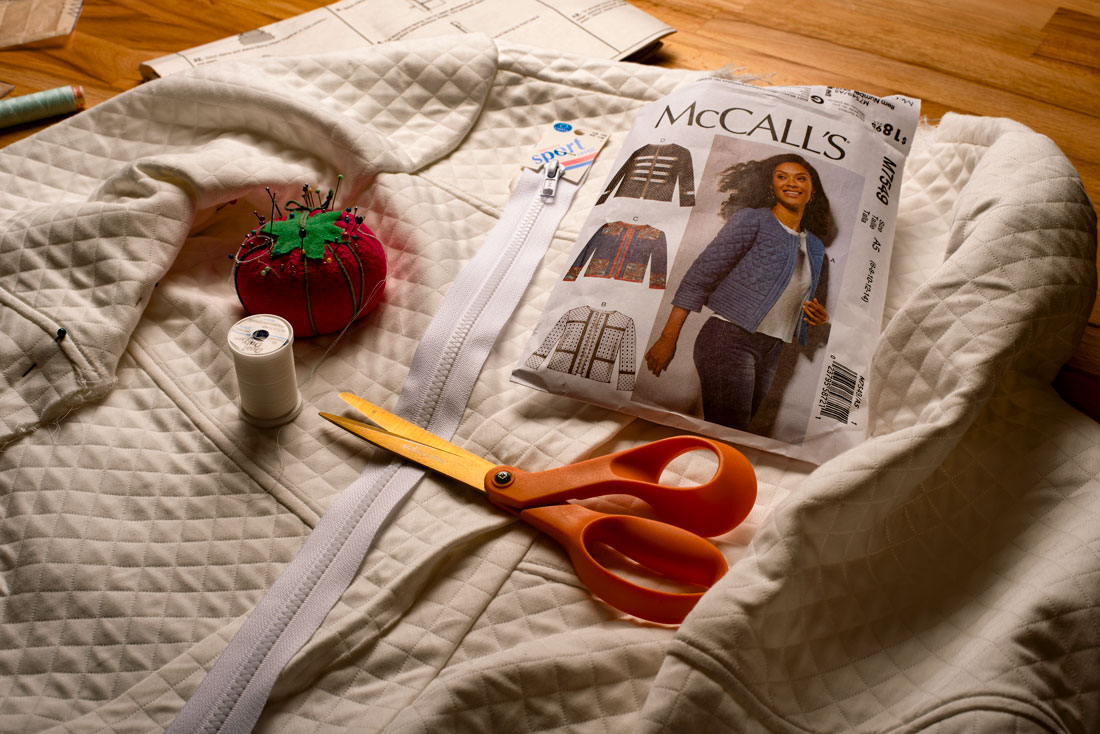
Sewing teaches spatial principles.
If you find that you love doing a type of craft, pursue it as far as you want regardless of whether other people think it is of value or that it is too simple. Some of the greatest art has been made with a simple notebook and paper. I have a friend who creates masterpiece 3D greeting cards with paper, glue and scissors. I know another woman who gathers simple grasses by the roadside, dries them and creates beautiful baskets and flower arrangements. Crafting doesn’t have to require expensive or complex skills, settings or materials.
Crafts have become politicized during many crises and the current one is no exception. Quilting in particular has long been associated with political symbols, but all crafted items reflect the mood of their times. Masks are the most common craft item to be politicized during the pandemic as calls went out early on for people to make masks for medical workers and some people have since rebelled against wearing them.
The pandemic has forced the crafting industry to pivot away from in-store purchases and classes and toward on-line ones. Some artists and museums have turned to giving on-line classes. Hashtags such as #quarantinecrafts, #coronacrafts and #covidcrafts showcase crafts made during the pandemic, including samplers that encourage people to wash their hands. On-line sales of sewing materials have gone up by almost 400 percent at some stores, while craft kit purchases have increased more than 200 percent. Among the more popular items are craft kits.
Many creative companies have shifted their emphasis to connecting with their at-home audience, meeting and serving them where they are at home with craft ideas, on-line communities and encouraging creativity to relieve stress. Adhesives brand Beacon launched a #sticktogetherchallenge campaign on Instagram to encourage people to share their crafts. UK-based paint brand Culture Hustle has given paint to children, made a coloring book available for free download, and streamed free life drawing classes on Facebook. Lion Brand yarn has a free Facebook Live show called Crafting Connection which encourages people to hang out online while knitting or crocheting. Art supply company Crayola partnered with Lynn Lily of Craft Box Girls to share crafts that use their products along with simple household items that most people have on hand. This is a resource for parents looking for ways to help children do art projects.
Crafts have been used as a way to support vulnerable groups during the pandemic, such as women at risk and those with compromised immune systems who have to stay home to avoid contracting the coronavirus. Charities have provided craft kits for these people to use at home.
In Britain, a charity called Changing Lives joined with Northumbria University to launch the Sewing Through the Pandemic initiative.This project, originally designed to help women who had experienced trauma recover through crafts, was adapted so that these women could use craft kits at home. The women were asked to sew a few stitches daily onto a white square in the color that represented how they felt every day. The squares are to be joined together to form a snapshot of life during the pandemic. The project expanded to include more than 80 women. Feedback has indicated that the project has helped women at risk to heal and overcome trauma.
Veterans suffering from conditions of old age or combat injuries, some of whom have post traumatic stress or suffer from substance abuse, have been vulnerable during the pandemic. A group called Help Heal Veterans has shipped more than 150,000 free craft kits to veterans. The kits include leatherwork, models, woodwork, jewelry, paint-by-numbers, needlecrafts, poster art, scrapbooks, mask making and other types of crafts. Kits have been distributed to more than 90 Veterans Affairs (VA) medical centers and to military bases, state veteran homes and other locations. A survey indicated that 94 percent of vets who use the kits say they help them have a more positive outlook, and 98 percent say they take their mind off their problems.
Check out these related items

Minimalist Jewelry with Meaning
A silversmith's pared down designs lend understated focus to a minimalist wardrobe and help simplify clothing for a busy lifestyle.

Reclaimed Wood Gets A New Life
Japanese carpenters say that wood gets a new life when it is made into a new form. See some new of these new lives.

Hand Typing
Simple, legible, careful handwriting on beautiful paper seems old-fashioned in a digital era, but an iOS app developer counts it as one of his most useful tools.

Dolls with Souls
Japan's magnificent tradition of fine doll making is a miniature window into the nation's culture and history.

Park City’s Kimball Arts Festival
The Kimball Arts Festival in Park City, Utah, is a feast for art enthusiasts. Here are our favorites from this year's show.
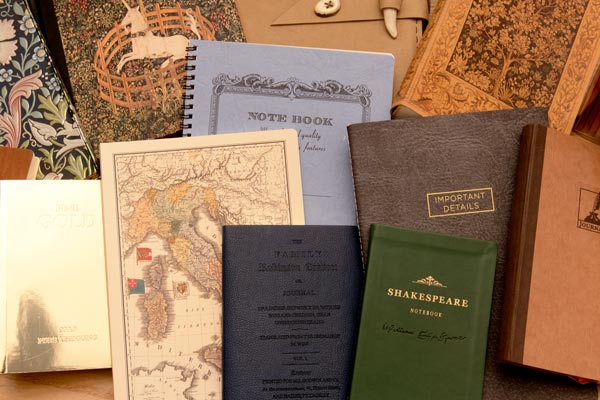
Journal Strokes for Different Folks
Journaling is an eye- and heart-opening strategy that helps people sort out their lives and feelings and work out their problems.
